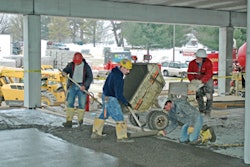

The soil simply was not cooperating with Sterling Development Inc.'s plan for a 42,000-square-foot specialty retail center called Sport Court at the vacant corner of Culture and Mercantile NE.
"We couldn't have picked a harder site to build on," said president Philip Sterling.
There were questions about the 3.6-acre site's stability.
"It's in a former quarry," Sterling said. "All they did when they abandoned the quarry was bulldoze stuff into the holes. There was no compaction. There was no engineered soil."
A preliminary soil analysis showed that the standard method of laying a commercial building foundation would work. A second analysis last fall showed that it would not.
"We knew we had a problem because of the discrepancy in the two reports," he said.
Sterling Development was committed to the site because of signed leases with three major retailers new to the Albuquerque market: Austin-based Golfsmith Stores, Chapel Hill, N.C.-based Performance Bicycle and Tucson-based Tres Amigos World Imports.
"We had our leases so we were transactionally bound," Sterling said. "I think a lot of people would've walked away."
Searching
The solution, which took some time to find, is a method of soil stabilization called compaction grouting. Essentially, it involves drilling hundreds of 3 1/2-inchwide holes and filling them with a cement grout.
"It's relatively unusual," said Tony Thomas, president of Summit Construction Inc. and Sterling's general contractor. "We have never worked on a project in Albuquerque that utilized this method."
"Most of the soils here (metro area) require some sort of ground modification" before building construction can start, said Kevin Scott of Terracon, engineering and science consultants working on the Sterling project.
The standard way to prepare a commercial building site is called over-excavation, which starts with digging a big trench. The backfill is "engineered," which is often as simple as adding moisture, before it is put back in the trench and compacted. More backfill is almost always needed from somewhere else.
A stable base
The goal is a stable base for the building foundation and slab. The trenches are frequently shallow, with about five feet being the norm. The depth is determined by a soil analysis.
A commercial building near his 3.6-acre site in the Renaissance area had required a 16- or 17-foot-deep over-excavation, Sterling said. He added that the building's developer advised, "Do your homework."
Terracon's finding for Sterling's project was a 36-footdeep hole. But it wasn't a recommendation for the site, Scott said, because "to over-excavate to that depth wouldn't be practical."
The search was on for an alternative. The first proposal was to put the project's two planned buildings above ground on steel-and-concrete piers.
"It was going to be in excess of $2 million," Sterling said. "We said, 'Holy cow!' We started Googling foundations on the Internet."
Sport Court plan
The 42,000-square-foot project, called Sport Court, was already falling behind schedule when Sterling hooked up with the Broomfield, Colo., office of Hayward Baker Inc. early this year.
Headquartered in Maryland, Hayward Baker specializes in geotechnical construction, or projects involving extensive site improvements.
More than eight years ago, the company used compaction grouting to stabilize the Hampton Inn at 5101 Ellison NE. The problem was collapsible soil, probably an accumulation of windblown silt, causing the building to settle.
Drilling
After a study of Sterling's site, Hayward Baker's solution was 800 to 900 holes drilled in a grid across the footprint of each of Sport Court's two buildings. Each 3 1/2-inch-wide hole is drilled to a depth of about 35 feet.
The next step, which immediately follows the drilling, compacts the soil. Beginning at the bottom, cement is injected under pressure into the bored hole.
"As you pump it in, the cement pushes the sand out and densifies it," said Tom Szynakiewicz, project manager for Hayward Baker. "The more voids you have, the more it densifies, so you don't get much settling."
The process cost about $758,000 and took only three or four weeks, Sterling said. "Once again, this project looked attractive."
Sport Court is now scheduled for completion in January, seven months behind the original date in June.
Tenants on board
Remarkably, all three signed tenants stayed on board.
The delay had no effect on Golfsmith, a golf and tennis specialty retailer whose lease was not to start until January.
But Performance Bicycles and Tres Amigos will miss more than a half-year of sales, including the holiday season.
The main reason for the patience is Sport Court's location, said Keith Kramer of Tres Amigos, which sells rustic Mexico-style furniture.
At the northwest corner of Interstate 25 and Montaño Boulevard, the location "is in the center of town with a good mix of retail already," he said.
In addition, Tres Amigos is opening a store in Rio Rancho in October, he said; as a result, it will establish a presence and still capture some holiday sales.
Copyright 2005 LexisNexis, a division of Reed Elsevier Inc. All rights reserved.
Terms and Conditions | Privacy Policy
News stories provided by third parties are not edited by "Site Publication" staff. For suggestions and comments, please click the Contact link at the bottom of this page.


















